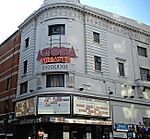The Flying Horse
FitzroviaGrade II* listed buildings in the City of WestminsterGrade II* listed pubs in the City of WestminsterLondon building and structure stubsNational Inventory Pubs ... and 4 more
Oxford StreetPub stubsUnited Kingdom listed building stubsUse British English from April 2014

The Flying Horse (previously The Tottenham) is a Grade II* listed public house at 6 Oxford Street, Fitzrovia, Westminster. It was built in the 19th century, and is the last remaining pub on Oxford Street. The pub is on the Campaign for Real Ale's National Inventory of Historic Pub Interiors.Known for a time as The Tottenham, it was renamed the Flying Horse in 2015, the pub's name prior to its redevelopment in 1894.
Excerpt from the Wikipedia article The Flying Horse (License: CC BY-SA 3.0, Authors, Images).The Flying Horse
Oxford Street, City of Westminster Bloomsbury
Geographical coordinates (GPS) Address Nearby Places Show on map
Geographical coordinates (GPS)
| Latitude | Longitude |
|---|---|
| N 51.516565 ° | E -0.130808 ° |
Address
Oxford Street 6
W1D 1AP City of Westminster, Bloomsbury
England, United Kingdom
Open on Google Maps







